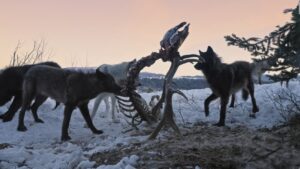It is 1957, and the world is a very different place. It is less globalized but still reeling from a global war. Old empires are collapsing, independence movements are flowering and “new” nations have been born.
Neil Armstrong and Buzz Aldrin are still 12 years away from taking one small step for man, but we have managed to create thermonuclear weapons, and the threat of annihilation hangs in the air. The world is still 46 years from the first iPhone. Mercifully, live video-blogging your every action is still just a dystopian nightmare dreamed up by sci-fi writers. All this to say, I would not have expected 1957 to produce an immersive, panoramic travelogue to rural Hunza, Pakistan.
Long before every Tom, Dick and Harry produced a running diary of their travels, it required some serious logistics to preserve your “holiday” for posterity, and Search for Paradise was cutting edge. Part of a series of films made with the Cinerama technique, Search for Paradise was designed for extra-wide screens. Sort of early IMAX. The effect was achieved by projecting images simultaneously from three synchronized 35mm projectors onto a huge, deeply curved screen in a 146° arc.

The soundtrack art is fantastic too.
Hunza isn’t the easiest place to reach even in 2020, so carting film equipment from the United States to the remote valleys must have been tricky in 1957. But true to a Hollywood production, everything is presented as smooth sailing; a perfect, happy adventure holiday into “valleys next door to nowhere.”
The film begins with strangely foreboding music before we are whisked off down some jaw-dropping Karakorum roads in first-person. The footage is quite remarkable for the time. We are told that our driver, Mustafa, knows every stone of these mountain roads. This is fortunate because he drives like a lunatic. Taking the corners like a professional rally driver, Mustafa clearly has chops. The dramatic narrator agrees: “He could drive this mountain trail with his eyes closed, but don’t you dare close your eyes, Mustafa.”
The narrator is full of pithy quotes, as well as some very dated statements. The word “primitive” is used three times in the first five minutes, and the people of Hunza are described as “in physical type…like southern Europeans”, thanks to their dubious links to Alexander the Great.
Soon, the jeep is ditched and the two western protagonists (known only as “the Sarge” and “Major Steve”) are off on horseback for a long ride towards Baltit, the former capital of the Hunza Kingdom. They are greeted by the Mir of Hunza, and we are treated to bucolic scenes of palace life. There’s even a game of polo; our narrator happily describes the action: “Where is the referee? There is none! What are the rules of the game? There are none, to speak of. Anything goes, short of mayhem.”
In the final act, the film morphs into what seems to be a tourist board advertisement. Dreamy music, idyllic scenery, and some hilarious quotes. Hunza is “paradise without poverty” and “many diseases common elsewhere are unheard-of here.” The beautiful footage is sound-tracked by a catchy song, further extolling the region’s virtues. Choice lines include: “they don’t need pills to cure their ills”, “they snub the cup that cheers, no alcohol is used at all” and my personal favorite, “there’s no one passing laws and acts, no cops, no jails, no income tax, they live and laugh and just relax, in Hunza.”
Our narrator is certainly sold: “No lawyers? Utopia!”






